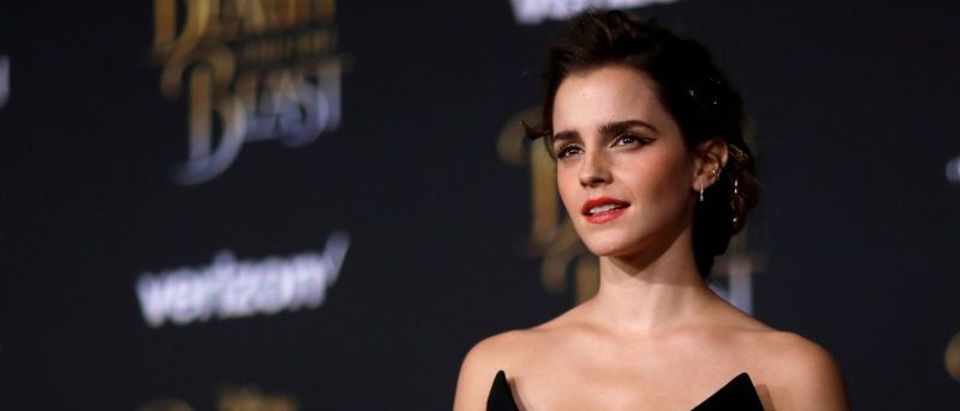The brouhaha around today’s release of the live-action remake of Disney’s 1991 animated classic Beauty and the Beast has focused on a supposed gay character, whose inclusion has led some theaters and countries to eschew its exhibition. But there’s so much material that’s “strange, no question” in Disney’s retelling of this tale as old as time that anyone can find something to object to – in fact, given the film’s bizarre politics, a bit of chaste homosexuality seems rather tame.
(This essay draws examples from the animated film, Broadway musical, theme park stage shows, and portions of the remake.)
Disney’s Beauty is a Stockholm Syndrome romance, in which the heroine falls in love with her captor – and everyone seems to be OK with it, including other characters and Disney’s immense audience.
Belle has been celebrated as a feminist Disney heroine who loves intellectual pursuits and, in the new film, has a career as an inventor. And indeed, the original 18th century tale’s beauty was a pioneering model of a woman who chooses her own husband – a sort of Tseitel for the French countryside.
But Disney’s Belle is a strange feminist. She starts the film singing “I want adventure in the great wide somewhere,” but unless you count being rescued from wolves there’s not much adventure in the story. Her only great wide somewhere is the castle’s ballroom, where she culminates her project of civilizing a rough-hewn male to make him suitable for conventional domesticity.
That’s not feminism, that’s a classic misogynist plot device.
Besides, our heroine’s literal marquee trait is her beauty – not coincidentally the French translation of her name. The story’s moral that “Beauty Is Found Within” is upended when the Ever After couple is doubly gorgeous. In fact, “prince” in the story is really just another word for “handsome,” because there’s no evidence of a king or a kingdom at all, other than a house filled with servants.
And what about those servants? Their attitudes evoke a nobleman’s fantasy of what his butlers and maids think of him, but are hardly believable:
Life is so unnerving
For a servant who’s not serving
He’s not whole without a soul to wait upon.
Those words recall Uncle Remus, the happy ex-slave spinning tales on a plantation in Song of the South – the only major Disney movie never released on video, because of its racist tones.
And speaking of racist tones, what’s with Monsieur D’Arque, the hook-nosed, dark (D’Arque) villain who spends his only scene caressing a gold coin and planning to lock away Belle’s father? Jew notice that?
As part of a Disney franchise, the gay identity of Gaston’s sidekick LeFou feels like a tempest in a (sorry) teapot. That is, if he’s even gay at all; the film’s composer Alan Menken called the controversy “absurd” and blamed a gay journalist for raising the issue “to push this agenda.” He said any hint of homosexuality is not in the film “in any overt way at all.”
Which would make it completely consistent with the other gay characters in the Disney repertoire – from villains Scar and Jafar to trader Oaken from Frozen. The breathless headlines about a gay character in a Disney movie caused Disney fanboys and fangirls to roll our eyes. And the boycott of the film by an Alabama theater and censorship by Malaysia are similarly absurd. It’s a film about an interspecies relationship, for Heaven’s sake. After all, Leviticus 18:22 may condemn homosexuality, but Exodus 22:18 (reversing the numbers) does the same for bestiality.
There is one interesting gay angle to Disney’s Beauty and the Beast, though, that is virtually never discussed (says Google). In Howard Ashman’s original lyrics to the prologue, captured on the motion picture soundtrack, the Beast’s curse requires him “to learn to love another, and earn their love in return.” But at the film’s release several months later the line was changed to “earn her love in return.” The openly gay Ashman died before the film’s release, and was unable to object when someone at Disney decided to clarify that a romance with Gaston would not break the spell.
By the time the 1993 Broadway musical debuted, the original line had been restored, and it remains in the current movie.
Despite all the socio-political, well, queerness of the film, it remains enchanting and addicting, one of the finest achievements ever from the House of Mouse. Its richness means viewers can make of it what they want.
In that spirit, here’s what I’d say to those picketing the film for being too gay:
Be my guest.
David Benkof is a columnist for The Daily Caller, where this essay first appeared. Follow him on Twitter (@DavidBenkof) and Muckrack.com/DavidBenkof, or E-mail him at DavidBenkof@gmail.com.


